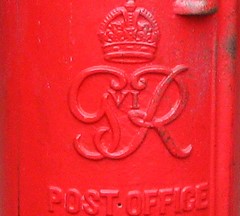6 June 2024
Post Box Politics
A tale of two kingdoms.
By Neil Tidmarsh

This week I’m in Edinburgh and yesterday I visited one of Auld Reekie’s most interesting and significant monuments. No, I didn’t go to Edinburgh Castle at one end of the Royal Mile, or to the Palace of Holyroodhouse or to the Scottish Parliament Building at the other end, or to the High Kirk of Saint Giles in the middle. And I didn’t climb Calton Hill to the National Monument either, or go to the Political Martyrs’ Monument in Old Calton Burial Ground.
Instead, I took a number 39 Lothian Bus to Inch, a 1950s housing estate some miles outside the city centre. There, on the corner of Gilmerton Road and Walter Scott Avenue, I found the object of my quest – a Royal Mail post box. It looks like any other old fashioned Royal Mail post box – a bright red cast-iron pillar box emblazoned with a royal cipher – and it’s been there since 1953. But it’s no ordinary post box. A closer look at that royal cipher immediately presents two mysteries. First, it’s highly unusual (unique, in fact) in having a royal cipher at all – all post boxes erected in Scotland for the last seventy-odd years simply display the heraldic Scottish crown instead. Second, it’s the cipher of George VI (‘G VI R’) – but that king had been dead for more than a year when this box was set up.
So what’s the story?
It’s a complex and explosive one of violent political protest. The building of the Inch housing scheme was completed in 1952, just after King George died and Queen Elizabeth was crowned. So it was decided that Scotland’s first post box embossed with the new queen’s insignia – E II R – would be installed in Edinburgh’s new suburban estate. But this very symbol triggered protests; many Scots refused to acknowledge the Queen’s title as the second Elizabeth, pointing out that the first Elizabeth hadn’t ruled Scotland. Elizabeth I had been queen of England only – in the sixteenth century, of course, Scotland had had its own king. It was an insulting and arrogant dismissal of Scotland’s separate history. The protests were vociferous enough to set off national media coverage, House of Commons debates and a security alert.
So there was a considerable police presence when the new ‘E II R’ post box was unveiled on the corner of Gilmerton Road and Walter Scott Avenue on 28 November 1953. But two days later its royal cipher was defaced with tar. Then, a week later, a postman discovered a makeshift bomb in the box. Fortunately it was defused before it could go off. Yet another bomb was discovered and defused a month after that. And then someone vandalised the box with a sledgehammer. It was removed, repaired and then replaced, only to be completely destroyed at 10pm on 12 February 1953 by a huge gelignite bomb. The explosion rocked Inch and could be heard over a mile away. The next day someone draped a Scots ‘Lion Rampant’ flag over the blackened ruins.
Queen Elizabeth’s right to be declared as the second of her name throughout the kingdom was subsequently debated in the Commons and in the courts and eventually upheld. But the demolished post box wasn’t replaced with a new one bearing the ‘Q II R’ insignia – it was replaced with an old one bearing the ‘George VI’ insignia. Thus the anxieties of the Inch residents and the sensitivities of proud Scots were recognised and assuaged. Two republican organisations claimed responsibility for the blast but no prosecutions were launched. And since then all post boxes, mail vans and other Royal Mail gear north of the border have been badged with the heraldic crown of Scotland instead of a royal cipher.
The claim that Elizabeth II was only Elizabeth I of Scotland was a subtle and sophisticated one, deserving a respectful consideration. After all, we’re used to the history books referring to James I and VI (ie the first of England and the sixth of Scotland). So Elizabeth II and I? And perhaps even Charles III and… what, exactly? Might some Scots claim that they’ve already had a Charles III, way back in the eighteenth century, when Bonnie Prince Charlie, exiled to Rome after defeat at Culloden, still insisted that he was the rightful heir to the throne? Well, best not go there, perhaps, in these uneasy times, and with a new king’s insignia beginning to appear throughout the kingdom. Today’s world is febrile and polarised enough as it is. But at least we can learn some useful and emollient lessons from the way in which inflamed political sensitivities were met with pragmatic compromises and concessions, and satisfied by them, some seventy years ago.


